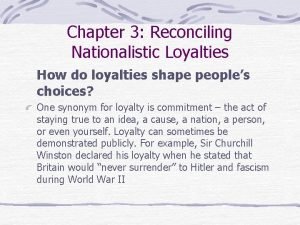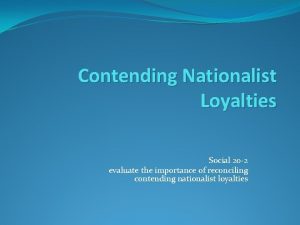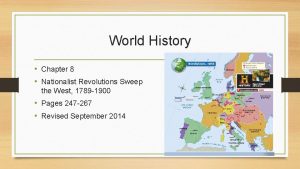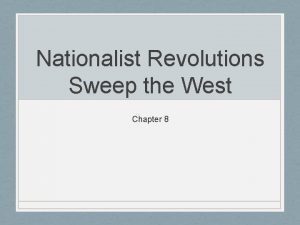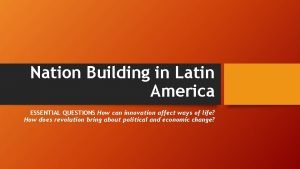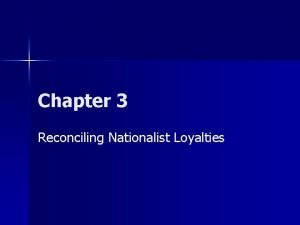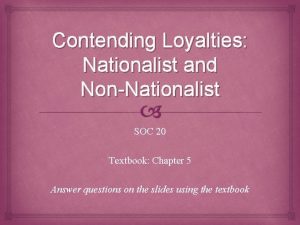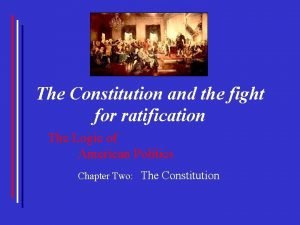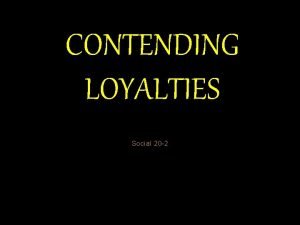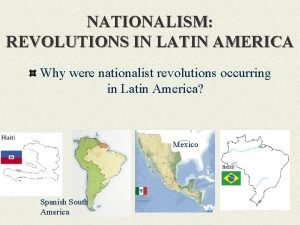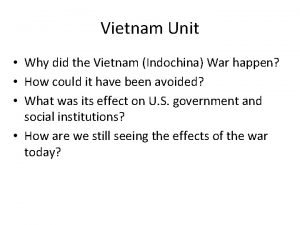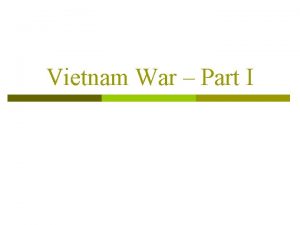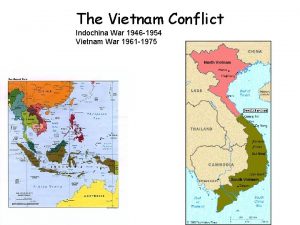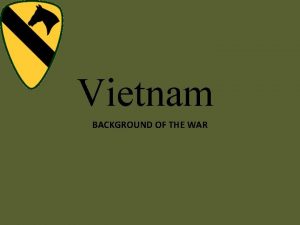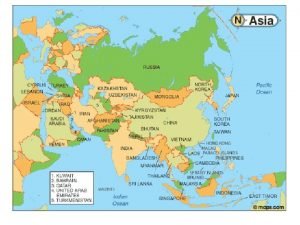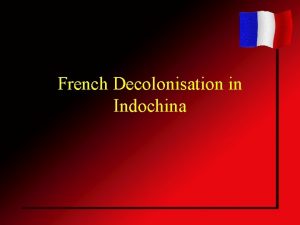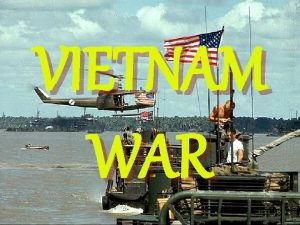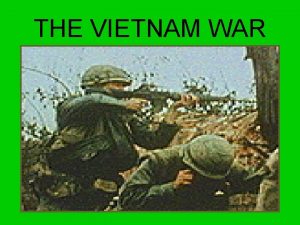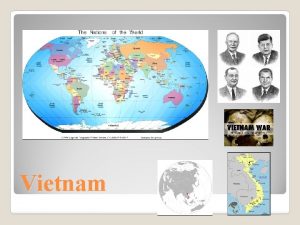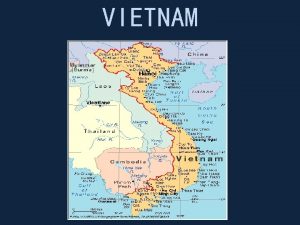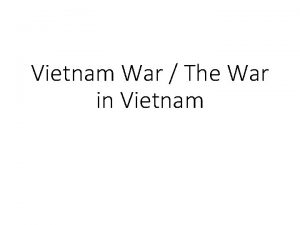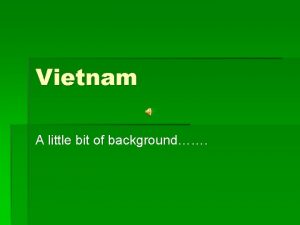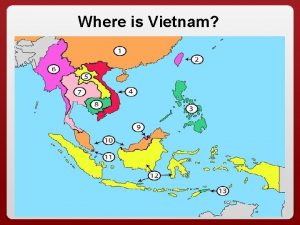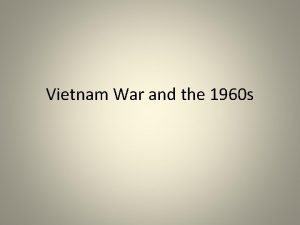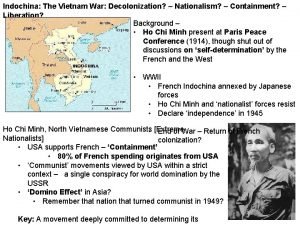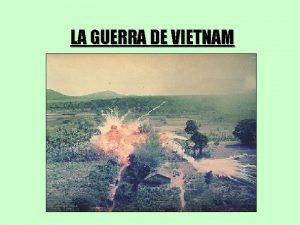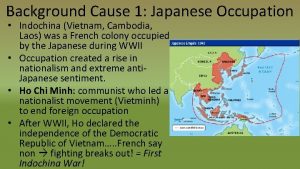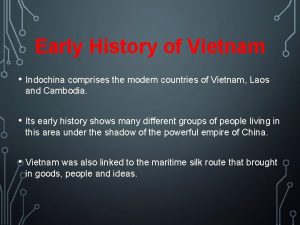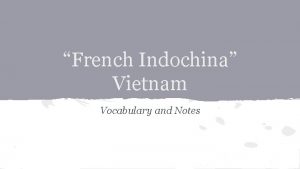THE NATIONALIST MOVEMENT IN INDOCHINA Vietnam gained formal


































































- Slides: 66

THE NATIONALIST MOVEMENT IN INDO-CHINA Vietnam gained formal indep India, but it took another three decades of fighting before the Republic of Vietnam was formed. This chapter on Indo-China will introduce you to one of the important states of the peninsula, namely, Vietnam. Nationalism in Indo-China developed in a colonial context. The knitting together of a modern Vietnamese nation that brought the different communities together was in part the result of colonisation but, as importantly, it was shaped by the struggle against colonial domination.


EMERGING FROM THE SHADOW OF CHINA • What was the status of Vietnam in its earlier history? • Indo-China comprises the modern countries of Vietnam, Laos and Cambodia (see Fig. 1). Its early history shows many different groups of people living in this area under the shadow of the powerful empire of China. Even when an independent country was established in what is now northern and central Vietnam, its rulers continued to maintain the Chinese system of government as well as Chinese culture

POINT OUT THE IMPORTANCE OF SILKROUTE • Vietnam was also linked to what has been called the maritime silk route that brought in goods, people and ideas. Other networks of trade connected it to the hinterlands where non-Vietnamese people such as the Khmer Cambodians lived

COLONIAL DOMINATION AND RESISTANCE • What was the most visible form of French control over Vietnam? • The colonisation of Vietnam by the French brought the people of the country into conflict with the colonisers in all areas of life. The most visible form of French control was military and economic domination but the French also built a system that tried to reshape the culture of the Vietnamese. Nationalism in Vietnam emerged through the efforts of different sections of society to fight against the French and all they represented.

• How did the French colonise Vietnam? • French troops landed in Vietnam in 1858 and by the mid-1880 s they had established a firm grip over the northern region. • After the Franco-Chinese war the French assumed control of Tonkin and Anaan and, in 1887, French Indo-China was formed. • In the following decades the French sought to consolidate their position, and people in Vietnam began reflecting on the nature of the loss that Vietnam was suffering. Nationalist resistance developed out of this reflection

WHY THE FRENCH THOUGHT COLONIES NECESSARY • Reasons for colonisation of Vietnam. Colonies were considered essential to supply natural resources and other essential goods. Like other Western nations, France also thought it was the mission of the ‘advanced’ European countries to bring the benefits of civilisation to backward peoples.

REASONS FOR COLONISATION • To supply natural resources • Civilizing mission

WHY DID THE FRENCH BEGIN BUILDING CANALS? • The French began by building canals and draining lands in the Mekong delta to increase cultivation. The vast system of irrigation works – canals and earthworks – built mainly with forced labour, increased rice production and allowed the export of rice to the international market. The area under rice cultivation went up from 274, 000 hectares in 1873 to 1. 1 million hectares in 1900 and 2. 2 million in 1930. Vietnam exported two-thirds of its rice production and by 1931 had become third largest exporter of rice in the world.

WHY WERE THE INFRASTRUCTURE PROJECTS MADE? WHAT DID THE FRENCH GOVT DO TO IMPROVE INFRASTRUCTURE IN COLONIAL VIETNAM • This was followed by infrastructure projects to help transport goods for trade, move military garrisons and control the entire region. • Construction of a trans-Indo-China rail network that would link the northern and southern parts of Vietnam and China was begun. • This final link with Yunan in China was completed by 1910. The second line was also built, linking Vietnam to Siam (as Thailand was then called), via the Cambodian capital of Phnom Penh.

WHO ADVOCATED THE DEVELOPMENT OF COLONIES LIKE VIETNAM? • Some like Paul Bernard, an influential writer and policy-maker, • The economy of the colonies needed to be developed. He argued that the purpose of acquiring colonies was to make profits. If the economy was developed and the standard of living of the people improved, they would buy more goods. The market would consequently expand, leading to better profits for French business.

WHAT WERE THE PROBLEMS IN THE ECONOMIC DEVELOPMENT OF VIETNAM? • Bernard suggested that there were several barriers to economic growth in Vietnam: high population levels, low agricultural productivity and extensive indebtedness amongst the peasants. To reduce rural poverty and increase agricultural productivity it was necessary to carry out land reforms as the Japanese had done in the 1890 s. However, this could not ensure sufficient employment. As the experience of Japan showed, industrialisation would be essential to create more jobs.

WHAT WAS THE BASIS OF THE COLONIAL ECONOMY OF VIETNAM? • The colonial economy in Vietnam was, however, primarily based on rice cultivation and rubber plantations owned by the French and a small Vietnamese elite. Rail and port facilities were set up to service this sector. • Indentured Vietnamese labour was widely used in the rubber plantations. The French, contrary to what Bernard would have liked, did little to industrialise the economy. In the rural areas landlordism spread and the standard of living declined

THE DILEMMA OF COLONIAL EDUCATION • French colonisation was not based only on economic exploitation. It was also driven by the idea of a ‘civilising mission’. Like the British in India, the French claimed that they were bringing modern civilisation to the Vietnamese. They took for granted that Europe had developed the most advanced civilisation. So it became the duty of the Europeans to introduce these modern ideas to the colony even if this meant destroying local cultures, religions and traditions, because these were seen as outdated and prevented modern development

DEBATE • Colonial rulers can never rule against the will of the colonised, however mighty they might be.

HOW WAS EDUCATION VIEWED BY THE FRENCH? • Education was seen as one way to civilise the ‘native’. But in order to educate them, the French had to resolve a dilemma. How far were the Vietnamese to be educated? • The French needed an educated local labour force but they feared that education might create problems. Once educated, the Vietnamese may begin to question colonial domination. Moreover, French citizens living in Vietnam (called colons) began fearing that they might lose their jobs – as teachers, shopkeepers, policemen – to the educated Vietnamese. So they opposed policies that would give the Vietnamese full access to French education.

TALKING MODERN MENTION TWO STEPS TAKEN BY FRENCH TO DISMANTLE THE INFLUENCE OF CHINESE? • The French were faced with yet another problem in the sphere of education: the elites in Vietnam were powerfully influenced by Chinese culture. To consolidate their power, the French had to counter this Chinese influence. 1. So they systematically dismantled the traditional educational system and established French schools for the Vietnamese. But this was not easy. Chinese, the language used by the elites so far, had to be replaced. But what was to take its place? • Was the language to be Vietnamese or French?

• What were the differences of opinion between the two groups in Vietnam regarding the introduction of French education system? • 2. There were two broad opinions on this question. Some policymakers emphasised the need to use the French language as the medium of instruction. By learning the language, they felt, the Vietnamese would be introduced to the culture and civilisation of France. This would help create an ‘Asiatic France solidly tied to European France’. The educated people in Vietnam would respect French sentiments and ideals, see the superiority of French culture, and work for the French. Others were opposed to French being the only medium of instruction. They suggested that Vietnamese be taught in lower classes and French in the higher classes.

GIVE AN EXAMPLE OF COLONIAL EDUCATION POLICY IN VIETNAM. • However, only the Vietnamese elite – comprising a small fraction of the population – could enroll in the schools, and only a few among those admitted ultimately passed the school-leaving examination. This was largely because of a deliberate policy of failing students, particularly in the final year, so that they could not qualify for the better-paid jobs. Usually, as many as two-thirds of the students failed. In 1925, in a population of 17 million, there were less than 400 who passed the examination.

HOW DID THE TEXTBOOK IN VIETNAM PROMOTE FRENCH OVER VIETNAM? • School textbooks glorified the French and justified colonial rule. The Vietnamese were represented as primitive and backward, capable of manual labour but not of intellectual reflection; they could work in the fields but not rule themselves; they were ‘skilled copyists’ but not creative. School children were told that only French rule could ensure peace in Vietnam:

• 3. The Tonkin Free School was started in 1907 to provide a Westernstyle education. This education included classes in science, hygiene and French (these classes were held in the evening and had to be paid for separately). • 4. In religion French introduced Christianity in Vietnam and gave a chanllenge to Confucianism , the chinese religion • Why did the school emphasize on modern look? The school’s approach to what it means to be ‘modern’ is a good example of the thinking prevalent at that time. It was not enough to learn science and Western ideas: to be modern the Vietnamese had to also look modern. The school encouraged the adoption of Western styles such as having a short haircut. For the Vietnamese this meant a major break with their own identity since they traditionally kept long hair. To underline the importance of a total change there was even a ‘haircutting chant’:

WHAT WAS THE ATTITUDE OF THE VIETNAMESE TOWARDS THE EDUCATIONAL POLICY OF FRENCH • 1. Teachers and students did not blindly follow the curriculum. Sometimes there was open opposition, at other times there was silent resistance. As the numbers of Vietnamese teachers increased in the lower classes, it became difficult to control what was actually taught. While teaching, Vietnamese teachers quietly modified the text and criticised what was stated.

EXAMPLE OF RESISTANCE MOVEMENT • 2. In 1926 a major protest erupted in the Saigon Native Girls School. A Vietnamese girl sitting in one of the front seats was asked to move to the back of the class and allow a local French student to occupy the front bench. She refused. The principal, also a colon (French people in the colonies), expelled her. When angry students protested, they too were expelled, leading to a further spread of open protests. Seeing the situation getting out of control, the government forced the school to take the students back. The principal reluctantly agreed but warned the students, ‘I will crush all Vietnamese under my feet. Ah! You wish my deportation. Know well that I will leave only after I am assured Vietnamese no longer inhabit Cochina. ’

3. Elsewhere, students fought against the colonial government’s efforts to prevent the Vietnamese from qualifying for white-collar jobs. They were inspired by patriotic feelings and the conviction that it was the duty of the educated to fight for the benefit of society. This brought them into conflict with the French as well as the traditional elite, since both saw their positions threatened. 4. By the 1920 s, students were forming various political parties, such as the Party of Young Annan, and publishing nationalist journals such as the Annanese Student

• Schools thus became an important place for political and cultural battles. The French sought to strengthen their rule in Vietnam through the control of education. They tried to change the values, norms and perceptions of the people, to make them believe in the superiority of French civilisation and the inferiority of the Vietnamese intellectuals, on the other hand, feared that Vietnam was losing not just control over its territory but its very identity: its own culture and customs were being devalued and the people were developing a master-slave mentality. The battle against French colonial education became part of the larger battle against colonialism and for independence

• What role did the vietnamese students play in its nationalist struggle against colonialism.

HYGIENE, DISEASE AND EVERYDAY RESISTANCE • Education was not the only sphere of everyday life in which such political battles against colonialism were fought. In many other institutions we can see the variety of small ways in which the colonised expressed their anger against the colonisers.

PLAGUE STRIKES HANOI • Which Vietnamese city was partially modernised? What was the symbol of modernity? • When the French set about creating a modern Vietnam, they decided to rebuild Hanoi. The latest ideas about architecture and modern engineering skills were employed to build a new and ‘modern’ city. • In 1903, the modern part of Hanoi was struck by bubonic plague. In many colonial countries, measures to control the spread of disease created serious social conflicts. But in Hanoi events took a peculiarly interesting turn.

WHY WAS THE NEWLY BUILT HANOI INFESTED WITH RATS? • The French part of Hanoi was built as a beautiful and clean city with wide avenues and a well-laid-out sewer system, while the ‘nativequarter’ was not provided with any modern facilities. The refuse from the old city drained straight out into the river or, during heavy rains or floods, overflowed into the streets. Thus what was installed to create a hygienic environment in the French city became the cause of the plague. The large sewers in the modern part of the city, a symbol of modernity, were an ideal and protected breeding ground for rats. The sewers also served as a great transport system, allowing the rats to move around the city without any problem. And rats began to enter the well-cared-for homes of the French through the sewage pipes.

WHAT LED TO THE FAILURE OF THE SEWAGE SYSTEM IN HANOI? • The large sewers in the modern part of the city, a symbol of modernity, were an ideal and protected breeding ground for rats. The sewers also served as a great transport system, allowing the rats to move around the city without any problem. And rats began to enter the well-cared-for homes of the French through the sewage pipes

HOW DID THE RAT CATCHERS TAKE ADVANTAGE OF THE SITUATION IN HANOI CITY? • To stem this invasion, a rat hunt was started in 1902. The French hired Vietnamese workers and paid them for each rat they caught. Rats began to be caught in thousands: on 30 May, for instance, 20, 000 were caught but still there seemed to be no end. For the Vietnamese the rat hunt seemed to provide an early lesson in the success of collective bargaining. Those who did the dirty work of entering sewers found that if they came together they could negotiate a higher bounty. They also discovered innovative ways to profit from this situation. The bounty was paid when a tail was given as proof that a rat had been killed. So the rat-catchers took to just clipping the tails and releasing the rats, so that the process could be repeated, over and over again. Some people, in fact, began raising rats to earn a bounty.

• Defeated by the resistance of the weak, the French were forced to scrap the bounty programme. None of this prevented the bubonic plague, which swept through the area in 1903 and in subsequent years. In a way, the rat menace marks the limits of French power and the contradictions in their ‘civilising mission’. And the actions of the rat-catchers tell us of the numerous small ways in which colonialism was fought in everyday life

RELIGION AND ANTICOLONIALISM • Vietnam’s religious beliefs were a mixture of Buddhism, Confucianism and local practices. Christianity, introduced by French missionaries, was intolerant of this easygoing attitude and viewed the Vietnamese tendency to revere the supernatural as something to be corrected

DESCRIBE THE SCHOLARS’ REVOLT • From the eighteenth century, many religious movements were hostile to the Western presence. An early movement against French control and the spread of Christianity was the Scholars Revolt in 1868. This revolt was led by officials at the imperial court angered by the spread of Catholicism and French power. • They led a general uprising Ngu An and Ha Tien provinces where over a thousand Catholics were killed. Catholic missionaries had been active in winning converts since the early seventeenth century, and by the middle of the eighteenth century had converted some 300, 000. The French crushed the movement but this uprising served to inspire other patriots to rise up against them.

• The elites in Vietnam were educated in Chinese and Confucianism. • But religious beliefs among the peasantry were shaped by a variety of syncretic traditions that combined Buddhism and local beliefs. • There were many popular religions in Vietnam that were spread by people who claimed to have seen a vision of God. Some of these religious movements supported the French, but others inspired movements against colonial rule.

EXPLAIN HOA HAO MOVEMENT. • One such movement was the Hoa Hao. It began in 1939 and gained great popularity in the fertile Mekong delta area. It drew on religious ideas popular in anti-French uprisings of the nineteenth century. • The founder of Hoa Hao was a man called Huynh Phu So. He performed miracles and helped the poor. His criticism against useless expenditure had a wide appeal. He also opposed the sale of child brides, gambling and the use of alcohol and opium.

• The French tried to suppress the movement inspired by Huynh Phu So. They declared him mad, called him the Mad Bonze, and put him in a mental asylum. Interestingly, the doctor who had to prove him insane became his follower, and finally in 1941, even the French doctors declared that he was sane. The French authorities exiled him to Laos and sent many of his followers to concentration camps

GIVE AN ACCOUNT OF THE ANTI FRENCH RELIGIOUS MOVEMENT. OR WHAT WAS THE ROLE OF THE RELIGIOUS GROUPS IN THE DEVELOPMENT OF ANTI COLONIAL FEELING IN VIETNAM • Scholars revolt • Hoa Hao movement

THE VISION OF MODERNISATION WHAT DID THE VIETNAMESE INTELLECTUALS DEBATE UPON? • French colonialism was resisted at many levels and in various forms. But all nationalists had to grapple with one set of questions: What was it to be Modern? What was it to be Nationalist? • In order to be modern, was it necessary to regard tradition as backward and reject all earlier ideas and social practices? • Was it necessary to consider the ‘West’ as the symbol of development and civilisation, and try and copy the West? • Different answers were offered to such questions. Some intellectuals felt that Vietnamese traditions had to be strengthened to resist the domination of the West, while others felt that Vietnam had to learn from the West even while opposing foreign domination. These differing visions led to complex debates, which could not be easily resolved

WHO WAS PHAN BOI CHAU? GIVE THE CONTRIBUTIONS OF PHAN BOI CHAU • 1. In the late nineteenth century, resistance to French domination was very often led by Confucian scholar-activists, who saw their world crumbling. Educated in the Confucian tradition, Phan Boi Chau (1867 -1940) was one such nationalist. 2. He became a major figure in the anti-colonial resistance. 3. He formed the Revolutionary Society (Duy Tan Hoi) in 1903, with Prince. Cuong De as the head. Phan Boi Chau met the Chinese reformer Liang Qichao (18731929) in Yokohama in 1905. 3. Phan’s most influential book, The History of the Loss of Vietnam was written under the strong influence and advice of Qichao.

PHAN CHAU TRINH • Other nationalists strongly differed with Phan Boi Chau. One such was Phan Chu Trinh (1871 -1926). He was intensely hostile to the monarchy and opposed to the idea of resisting the French with the help of the court. His desire was to establish a democratic republic. Profoundly influenced by the democratic ideals of the West, he did not want a wholesale rejection of Western civilisation. He accepted the French revolutionary ideal of liberty but charged the French for not abiding by the ideal. He demanded that the French set up legal and educational institutions, and develop agriculture and industries

WHAT WAS PHAN CHU TRINH’S OBJECTIVE FOR VIETNAM? HOW WERE HIS IDEAS DIFFERENT FROM PHAN BOI CHAU

• What significant role did Japan play in the Vietnamese struggle for independence? • Early Vietnamese nationalists had a close relationship with Japan and China. In the first decade of the twentieth century a ‘go east movement’ became popular. • In 1907 -08 some 300 Vietnamese students went to Japan to acquire modern education. For many of them the primary objective was to drive out the French from Vietnam, overthrow the puppet emperor and re-establish the Nguyen dynasty that had been deposed by the French. • These nationalists looked foreign arms and help. They appealed to the Japanese as fellow Asians. Japan had modernised itself and had resisted colonisation by the West.

Besides, its victory over Russia in 1907 proved its military capabilities. Vietnamese students established a branch of the Restoration Society in Tokyo but after 1908, the Japanese Ministry of Interior clamped down on them. Many, including Phan Boi Chau, were deported and forced to seek exile in China and Thailand.

WHY DID THE VIETNAMESE NATIONALISTS CHANGE THEIR OBJECTIVE FROM CONSTITUTIONAL MONARCHY TO REPUBLIC • Developments in China also inspired Vietnamese nationalists. In 1911, the long established monarchy in China was overthrown by a popular movement under Sun Yat-sen, and a Republic was set up. Inspired by these developments, Vietnamese students organised the Association for the Restoration of Vietnam. Now the nature of the anti-French independence movement changed. The objective was no longer to set up a constitutional monarchy but a democratic republic

WRITE A SHORT NOTE ON THE ROLE OF HO CHI MINH. STATE HIS CONTRIBUTION IN THE FREEDOM MOVEMENT OF VIETNAM • In February 1930, Ho Chi Minh brought together competing nationalist groups to establish the Vietnamese Communist (Vietnam Cong San Dang) Party, later renamed the Indo. Chinese Communist Party. He was inspired by the militant demonstrations of the European communist parties

• In 1940 Japan occupied Vietnam, as part of its imperial drive to control Southeast Asia. So nationalists now had to fight against the Japanese as well as the French. The League for the Independence of Vietnam (which came to be known as the Vietminh, fought the Japanese occupation and recaptured Hanoi in September 1945. The Democratic Republic of Vietnam was formed by Ho Chi Minh and he became Chairman. He struggled hard to preserve the Vietnam autonomy. He is rightly called the maker of modern Vietnam.

WHAT WERE THE NEW CHALLENGES FACED BY THE NEW REPUBLIC OF VIETNAM OR HOW AND BY WHOM WERE THE JAPANESE DRIVEN OUT OF VIETNAM? The League for the Independence of Vietnam (Viet Nam Doc Lap Dong Minh), which came to be known as the Vietminh, fought the Japanese occupation and recaptured Hanoi in September 1945. The Democratic Republic of Vietnam was formed by Ho Chi Minh and he became Chairman. He struggled hard to preserve the Vietnam autonomy. He is rightly called the maker of modern Vietnam. • The new republic faced a number of challenges. The French tried to regain control by using the emperor, Bao Dai, as their puppet. Faced with the French offensive, the Vietminh were forced to retreat to the hills. After eight years of fighting, the French were defeated in 1954 at Dien Bien Phu

• The Supreme French Commander of the French armies, General Henry Navarre had declared confidently in 1953 that they would soon be victorious. • But on 7 May 1954, the Vietminh annihilated and captured more than 16, 000 soldiers of the French Expeditionary Corps. The entire commanding staff, including a general, 16 colonels and 1, 749 officers, were taken prisoner. In the peace negotiations in Geneva that followed the French defeat, the Vietnamese were persuaded to accept the division of the country.

EXAMINE THE EVENTS THAT TURNED VIETNAM INTO A BATTLEFIELD. • After the Geneva conference the division of Vietnam set in motion a series of events that turned Vietnam into a battlefield bringing death and destruction to its people as well as the environment. The Bao Dai regime was soon overthrown by a coup led by Ngo Dinh Diem. • Diem built a repressive and authoritarian government. Anyone who opposed him was called a communist and was jailed and killed. Diem retained Ordinance 10, a French law that permitted Christianity but outlawed Buddhism. His dictatorial rule came to be opposed by a broad opposition united under the banner of the National Liberation Front (NLF). • With the help of the Ho Chi Minh government in the north, the NLF fought for the unification of the country. The US watched this alliance with fear. Worried about communists gaining power, it decided to intervene decisively, sending in troops and arms.

EXPLAIN THE CAUSES OF US INVOLVEMENT IN THE WAR AGAINST VIETNAM • After the Geneva conference the division of Vietnam set in motion a series of events that turned Vietnam into a battlefield bringing death and destruction to its people as well as the environment. The Bao Dai regime was soon overthrown by a coup led by Ngo Dinh Diem. • Diem built a repressive and authoritarian government. Anyone who opposed him was called a communist and was jailed and killed. Diem retained Ordinance 10, a French law that permitted Christianity but outlawed Buddhism. His dictatorial rule came to be opposed by a broad opposition united under the banner of the National Liberation Front (NLF). • With the help of the Ho Chi Minh government in the north, the NLF fought for the unification of the country. The US watched this alliance with fear. Worried about communists gaining power, it decided to intervene decisively, sending in troops and arms.

2. The war grew out of a fear among US policy-planners that the victory of the Ho Chi Minh government would start a domino effect – communist governments would be established in other countries in the area. They underestimated the power of nationalism to move people to action, inspire them to sacrifice their home and family, live under horrific conditions, and fight for independence. They underestimated the power of a small country to fight the most technologically advanced country in the world

GIVE DETAILS OF US WAR WEAPONS IN VIETNAM • Thousands of US troops arrived equipped with heavy weapons and tanks and backed by the most powerful bombers of the time – B 52 s. The wide spread attacks and use of chemical weapons – Napalm, Agent Orange, and phosphorous bombs – destroyed many villages and decimated jungles. Civilians died in large numbers.

WHAT EFFECT DID THIS INVOLVEMENT HAVE ON LIFE WITHIN THE US ITSELF ? • The effect of the war was felt within the US as well. Many were critical of the government for getting involved in a war that they saw as indefensible. When the youth were drafted for the war, the anger spread. Compulsory service in the armed forces, however, could be waived for university graduates. This meant that many of those sent to fight did not belong to the privileged elite but were minorities and children of working-class families.

• The US media and films played a major role in both supporting as well as criticising the war. Hollywood made films in support of the war, such as John Wayne’s Green Berets (1968). • This has been cited by many as an example of an unthinking propaganda film that was responsible for motivating many young men to die in the war. Other films were more critical as they tried to understand the reasons for this war. • John Ford Coppola’s Apocalypse Now (1979) reflected the moral confusion that the war had caused in the US.

THE HO CHI MINH TRAIL EXPLAIN THE SIGNIFICANCE OF HO CHI MINH TRAIL. • The story of the Ho Chi Minh trail is one way of understanding the nature of the war that the Vietnamese fought against the US. • It symbolises how the Vietnamese used their limited resources to great advantage. The trail, an immense network of footpaths and roads, was used to transport men and materials from the north to the south. • The trail was improved from the late 1950 s, and from 1967 about 20, 000 North Vietnamese troops came south each month on this trail

What were the reasons for the success of the Trail? • The trail had support bases and hospitals along the way. • In some parts supplies were transported in trucks, but mostly they were carried by porters, who were mainly women. • These porters carried about 25 kilos on their backs, or about 70 kilos on their bicycles. • Most of the trail was outside Vietnam in neighbouring Laos and Cambodia with branch lines extending into South Vietnam. • The US regularly bombed this trail trying to disrupt supplies, but efforts to destroy this important supply line by intensive bombing failed because they were rebuilt very quickly.

THE NATION AND ITS HEROES • Another way of looking at social movements is to see how they affect different groups in society. Let us see how the roles of women were specified in the anti-imperialist movement in Vietnam, and what tells us about nationalist ideology.

WOMEN AS REBELS • What was the status of women in Vietnam before the nationalist movement? • Women in Vietnam traditionally enjoyed greater equality than in China, particularly among the lower classes, but they had only limited freedom to determine their future and played no role in public life. As the nationalist movement grew, the status of women came to be questioned and a new image of womanhood emerged. Writers and political thinkers began idealising women who rebelled against social norms. What was the contravorsial aspect of the novel by Nhat Linh? In the 1930 s, a famous novel by Nhat Linh caused a scandal because it showed a woman leaving a forced marriage and marrying someone of her choice, someone who was involved in nationalist politics. This rebellion against social conventions marked the arrival of the new woman in Vietnamese society

WHO WERE THE TRUNG SISTERS? • Rebel women of the past were similarly celebrated. In 1913, the nationalist Phan Boi Chau wrote a play based on the lives of the Trung sisters who had fought against Chinese domination in 39 -43 CE. In this play he depicted these sisters as patriots fighting to save the Vietnamese nation from the Chinese. The actual reasons for the revolt are a matter of debate among scholars, but after Phan’s play the Trung sisters came to be idealised and glorified. They were depicted in paintings, plays and novels as representing the indomitable will and the intense patriotism of the Vietnamese. We are told that they gathered a force of over 30, 000, resisted the Chinese for two years, and when ultimately defeated, they committed suicide, instead of surrendering to the enemy.

WHY WAS TRIEU AU WORSHIPPED IN VIETNAM? • One of the most venerated was Trieu Au who lived in the third century CE. Orphaned in childhood, she lived with her brother. On growing up she left home, went into the jungles, organised a large army and resisted Chinese rule. Finally, when her army was crushed, she drowned herself. She became a sacred figure, not just a martyr who fought for the honour of the country. Nationalists popularised her image to inspire people to action.

WOMEN AS WARRIORS • In the 1960 s, photographs in magazines and journals showed women as brave fighters. There were pictures of women militia shooting down planes. They were portrayed as young, brave and dedicated. Stories were written to show happy they felt when they joined the army and could carry a rifle. Some stories spoke of their incredible bravery in single-handedly killing the enemy – Nguyen Thi Xuan, for instance, was reputed to have shot down a jet with just twenty bullets

WHAT WAS THE ROLE OF WOMEN IN ANTI- IMPERIAL STRUGGLE IN VIETNAM? • Women were represented not only as warriors but also as workers: they were shown with a rifle in one hand a hammer in the other. Whether young or old, women began to be depicted as selflessly working and fighting to save the country. As casualties in the war increased in the 1960 s, women were urged to join the struggle in larger numbers.

WHEN DID THE IMAGE OF WOMEN CHANGE? WHAT WERE THE CHANGES? • By the 1970 s, as peace talks began to get under way and the end of the war seemed near, women were no longer represented as warriors. • Now the image of women as workers begins to predominate. They are shown working in agricultural cooperatives, factories and production units, rather than as fighters.

WHAT FACTORS LED TO THE END OF THE WAR • The prolongation of the war created strong reactions even within the US. It was clear that the US had failed to achieve its objectives: the Vietnamese resistance had not been crushed; the support of the Vietnamese people for US action had not been won. In the meantime, thousands of young US soldiers had lost their lives, and countless Vietnamese civilians had been killed. This was a war that has been called the first television war. Battle scenes were shown on the daily news programmes. Many became disillusioned with what the US was doing and writers such as Mary Mc. Carthy, and actors like Jane Fonda even visited North Vietnam and praised their heroic defence of the country. The scholar Noam Chomsky called the war ‘the greatest threat to peace, to national self-determination, and to international cooperation’.

WHEN AND WHERE WAS THE PEACE SETTLEMENT SIGNED? WHEN AND HOW WAS VIETNAM UNIFIED? • The widespread questioning of government policy strengthened moves to negotiate an end to the war. A peace settlement was signed in Paris in January 1974. This ended conflict with the US but fighting between the Saigon regime and the NLF continued. The NLF occupied the presidential palace in Saigon on 30 April 1975 and unified Vietnam
 Nothing ___ nothing gained
Nothing ___ nothing gained Etymology and morphology
Etymology and morphology The electrons available to be lost gained
The electrons available to be lost gained Gilded age westward expansion
Gilded age westward expansion Serbian nationalist
Serbian nationalist Reconciling loyalties
Reconciling loyalties What is non nationalist loyalties
What is non nationalist loyalties How do nationalist loyalties shape people's choices
How do nationalist loyalties shape people's choices National loyalties
National loyalties Contending nationalist loyalties
Contending nationalist loyalties Chapter 8 nationalist revolutions sweep the west
Chapter 8 nationalist revolutions sweep the west Which ideas of romanticism would encourage nationalism
Which ideas of romanticism would encourage nationalism How were nationalist revolts in latin america
How were nationalist revolts in latin america Define contending loyalties
Define contending loyalties Serbian nationalist
Serbian nationalist Nationalist position definition
Nationalist position definition Nationalist revolutions sweep the west
Nationalist revolutions sweep the west Contending loyalty
Contending loyalty Nationalist vs federalist
Nationalist vs federalist Contending loyalties
Contending loyalties How were nationalist revolts in latin america
How were nationalist revolts in latin america Locomotor meaning in dance
Locomotor meaning in dance Non movement area
Non movement area Thẻ vin
Thẻ vin Thể thơ truyền thống
Thể thơ truyền thống Hát lên người ơi alleluia
Hát lên người ơi alleluia Các châu lục và đại dương trên thế giới
Các châu lục và đại dương trên thế giới Từ ngữ thể hiện lòng nhân hậu
Từ ngữ thể hiện lòng nhân hậu Diễn thế sinh thái là
Diễn thế sinh thái là Vẽ hình chiếu vuông góc của vật thể sau
Vẽ hình chiếu vuông góc của vật thể sau Ví dụ về giọng cùng tên
Ví dụ về giọng cùng tên Làm thế nào để 102-1=99
Làm thế nào để 102-1=99 Tỉ lệ cơ thể trẻ em
Tỉ lệ cơ thể trẻ em Lời thề hippocrates
Lời thề hippocrates Hươu thường đẻ mỗi lứa mấy con
Hươu thường đẻ mỗi lứa mấy con đại từ thay thế
đại từ thay thế Quá trình desamine hóa có thể tạo ra
Quá trình desamine hóa có thể tạo ra Công của trọng lực
Công của trọng lực Thế nào là mạng điện lắp đặt kiểu nổi
Thế nào là mạng điện lắp đặt kiểu nổi Hát kết hợp bộ gõ cơ thể
Hát kết hợp bộ gõ cơ thể Các loại đột biến cấu trúc nhiễm sắc thể
Các loại đột biến cấu trúc nhiễm sắc thể Nguyên nhân của sự mỏi cơ sinh 8
Nguyên nhân của sự mỏi cơ sinh 8 Vẽ hình chiếu đứng bằng cạnh của vật thể
Vẽ hình chiếu đứng bằng cạnh của vật thể Phản ứng thế ankan
Phản ứng thế ankan Môn thể thao bắt đầu bằng chữ f
Môn thể thao bắt đầu bằng chữ f Gấu đi như thế nào
Gấu đi như thế nào Thiếu nhi thế giới liên hoan
Thiếu nhi thế giới liên hoan Sự nuôi và dạy con của hươu
Sự nuôi và dạy con của hươu điện thế nghỉ
điện thế nghỉ Một số thể thơ truyền thống
Một số thể thơ truyền thống Trời xanh đây là của chúng ta thể thơ
Trời xanh đây là của chúng ta thể thơ Ng-html
Ng-html Thế nào là số nguyên tố
Thế nào là số nguyên tố Tia chieu sa te
Tia chieu sa te Các châu lục và đại dương trên thế giới
Các châu lục và đại dương trên thế giới Thang điểm glasgow
Thang điểm glasgow Thế nào là hệ số cao nhất
Thế nào là hệ số cao nhất ưu thế lai là gì
ưu thế lai là gì Hệ hô hấp
Hệ hô hấp Tư thế ngồi viết
Tư thế ngồi viết đặc điểm cơ thể của người tối cổ
đặc điểm cơ thể của người tối cổ Cái miệng nó xinh thế chỉ nói điều hay thôi
Cái miệng nó xinh thế chỉ nói điều hay thôi Cách giải mật thư tọa độ
Cách giải mật thư tọa độ Bổ thể
Bổ thể Tư thế ngồi viết
Tư thế ngồi viết Difference between formal education and als
Difference between formal education and als Aap1 - história da educação
Aap1 - história da educação








